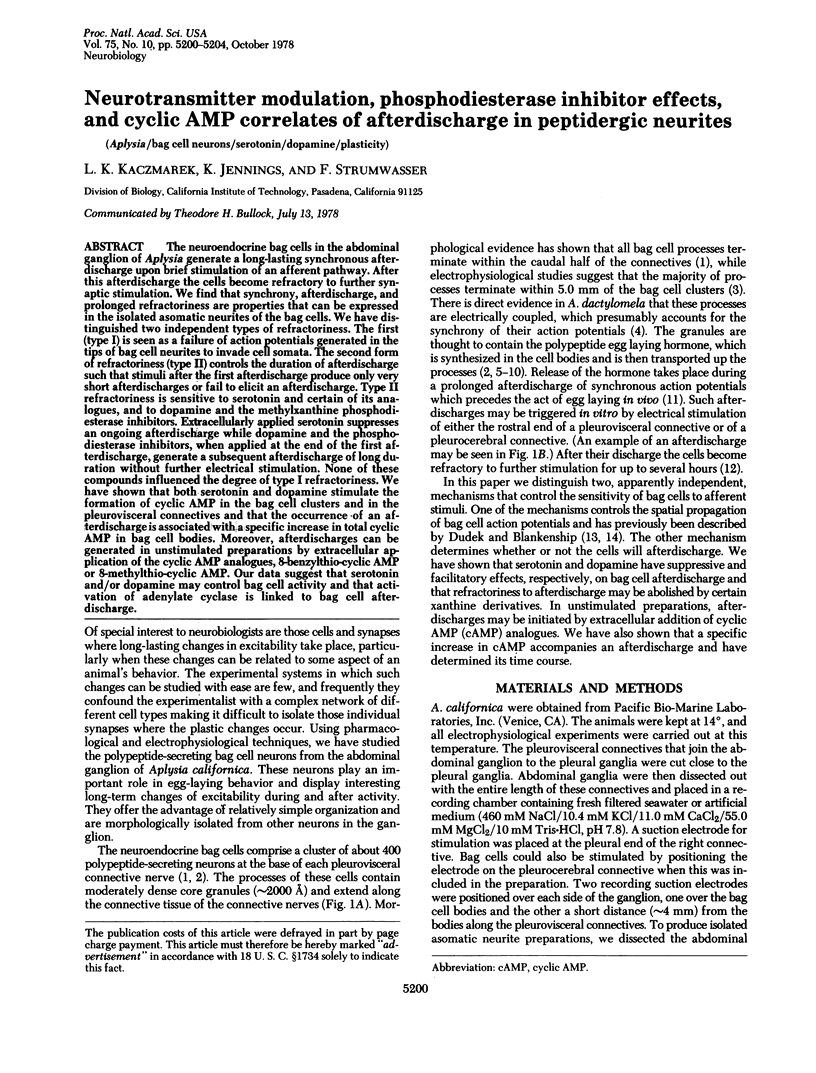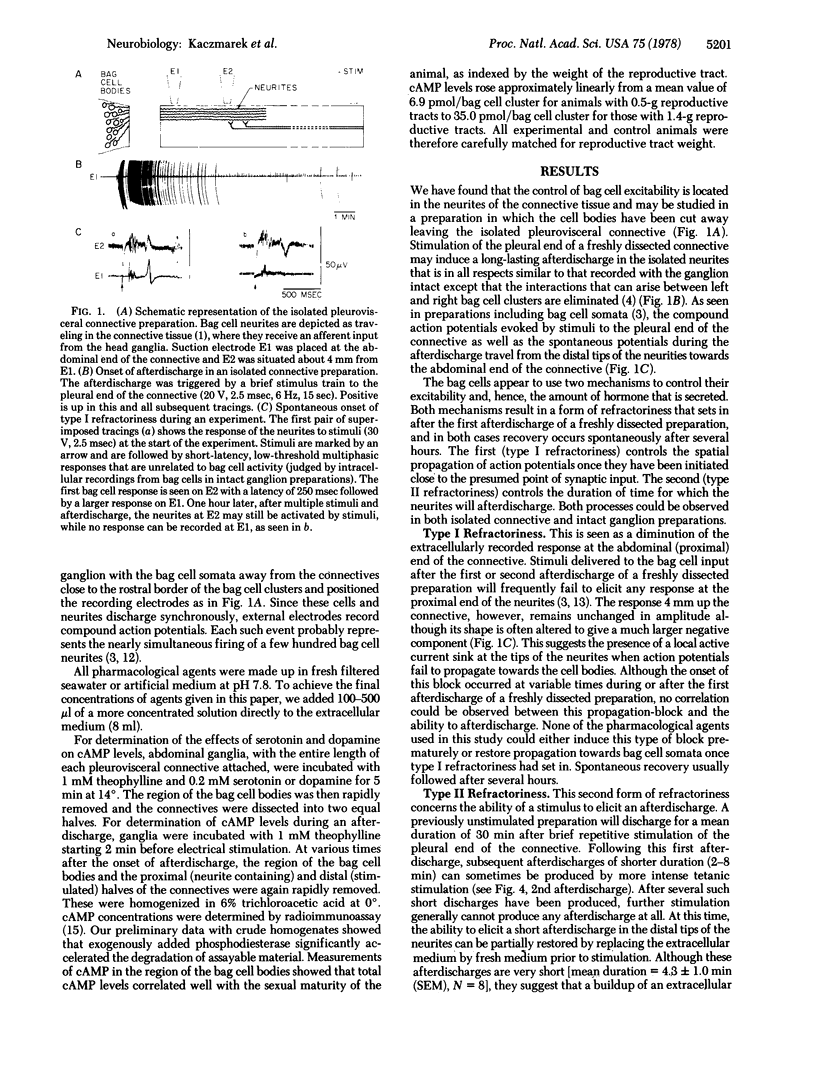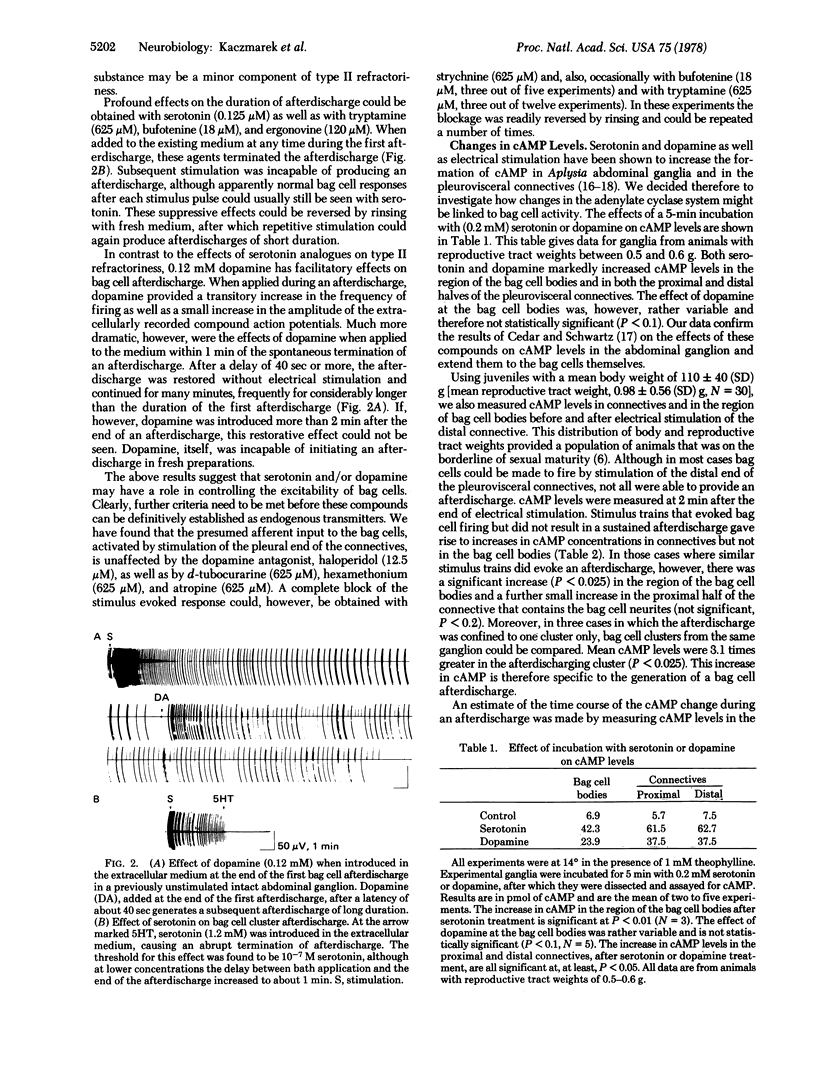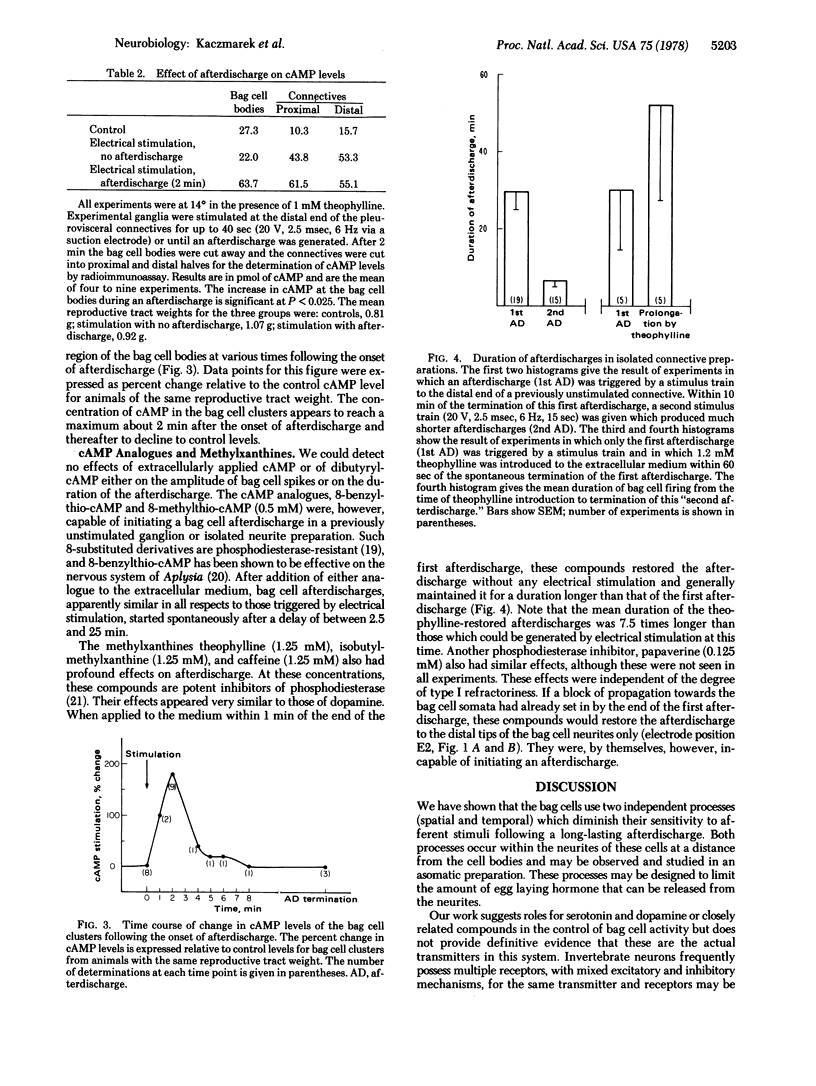Abstract
The neuroendocrine bag cells in the abdominal ganglion of Aplysia generate a long-lasting synchronous afterdischarge upon brief stimulation of an afferent pathway. After this afterdischarge the cells become refractory to further synaptic stimulation. We find that synchrony, afterdischarge, and prolonged refractoriness are properties that can be expressed in the isolated asomatic neurites of the bag cells. We have distinguished two independent types of refractoriness. The first (type I) is seen as a failure of action potentials generated in the tips of bag cell neurites to invade cell somata. The second form of refractoriness (type II) controls the duration of afterdischarge such that stimuli after the first afterdischarge produce only very short afterdischarges or fail to elicit an afterdischarge. Type II refractoriness is sensitive to serotonin and certain of its analogues, and to dopamine and the methylxanthine phosphodiesterase inhibitors. Extracellularly applied serotonin suppresses an ongoing afterdischarge while dopamine and the phosphodiesterase inhibitors, when applied at the end of the first afterdischarge, generate a subsequent afterdischarge of long duration without further electrical stimulation. None of these compounds influenced the degree of type I refractoriness. We have shown that both serotonin and dopamine stimulate the formation of cyclic AMP in the bag cell clusters and in the pleurovisceral connectives and that the occurrence of an afterdischarge is associated with a specific increase in total cyclic AMP in bag cell bodies. Moreover, afterdischarges can be generated in unstimulated preparations by extracellular application of the cyclic AMP analogues, 8-benzylthio-cyclic AMP or 8-methylthio-cyclic AMP. Our data suggest that serotonin and/or dopamine may control bag cell activity and that activation of adenylate cyclase is linked to bag cell afterdischarge.
Keywords: Aplysia, bag cell neurons, serotonin, dopamine, plasticity
Full text
PDF




Images in this article
Selected References
These references are in PubMed. This may not be the complete list of references from this article.
- Arch S. Biosynthesis of the egg-laying hormone (ELH) in the bag cell neurons of Aplysia californica. J Gen Physiol. 1972 Jul;60(1):102–119. doi: 10.1085/jgp.60.1.102. [DOI] [PMC free article] [PubMed] [Google Scholar]
- Arch S. Polypeptide secretion from the isolated parietovisceral ganglion of Aplysia californica. J Gen Physiol. 1972 Jan;59(1):47–59. doi: 10.1085/jgp.59.1.47. [DOI] [PMC free article] [PubMed] [Google Scholar]
- Cedar H., Kandel E. R., Schwartz J. H. Cyclic adenosine monophosphate in the nervous system of Aplysia californica. I. Increased synthesis in response to synaptic stimulation. J Gen Physiol. 1972 Nov;60(5):558–569. doi: 10.1085/jgp.60.5.558. [DOI] [PMC free article] [PubMed] [Google Scholar]
- Cedar H., Schwartz J. H. Cyclic adenosine monophosphate in the nervous system of Aplysia californica. II. Effect of serotonin and dopamine. J Gen Physiol. 1972 Nov;60(5):570–587. doi: 10.1085/jgp.60.5.570. [DOI] [PMC free article] [PubMed] [Google Scholar]
- Dudek F. E., Blankenship J. E. Neuroendocrine (bag) cells of Aplysia: spike blockade and a mechanism for potentiation. Science. 1976 Jun 4;192(4243):1009–1010. doi: 10.1126/science.1273581. [DOI] [PubMed] [Google Scholar]
- Dudek F. E., Blankenship J. E. Neuroendocrine cells of Aplysia brasiliana. I. Bag cell action potentials and afterdischarge. J Neurophysiol. 1977 Nov;40(6):1301–1311. doi: 10.1152/jn.1977.40.6.1301. [DOI] [PubMed] [Google Scholar]
- Dudek F. E., Blankenship J. E. Neuroendocrine cells of Aplysia brasiliana. II. Bag cell prepotentials and potentiation. J Neurophysiol. 1977 Nov;40(6):1312–1324. doi: 10.1152/jn.1977.40.6.1312. [DOI] [PubMed] [Google Scholar]
- Gerschenfeld H. M. Chemical transmission in invertebrate central nervous systems and neuromuscular junctions. Physiol Rev. 1973 Jan;53(1):1–119. doi: 10.1152/physrev.1973.53.1.1. [DOI] [PubMed] [Google Scholar]
- Kupfermann I., Kandel E. R. Electrophysiological properties and functional interconnections of two symmetrical neurosecretory clusters (bag cells) in abdominal ganglion of Aplysia. J Neurophysiol. 1970 Nov;33(6):865–876. doi: 10.1152/jn.1970.33.6.865. [DOI] [PubMed] [Google Scholar]
- Kupfermann I. Stimulation of egg laying by extracts of neuroendocrine cells (bag cells) of abdominal ganglion of Aplysia. J Neurophysiol. 1970 Nov;33(6):877–881. doi: 10.1152/jn.1970.33.6.877. [DOI] [PubMed] [Google Scholar]
- Kupfermann I. Stimulation of egg laying: possible neuroendocrine function of bag cells of abdominal ganglion of Aplysia californica. Nature. 1967 Nov 25;216(5117):814–815. doi: 10.1038/216814a0. [DOI] [PubMed] [Google Scholar]
- Levitan I. B., Madsen C. J., Barondes S. H. Cyclic AMP and amine effects on phosphorylation of specific protein in abdominal ganglion of Aplysia californica; localization and kinetic analysis. J Neurobiol. 1974;5(6):511–525. doi: 10.1002/neu.480050604. [DOI] [PubMed] [Google Scholar]
- Meyer R. B., Jr, Miller J. P. Analogs of cyclic AMP and cyclic GMP: general methods of synthesis and the relationship of structure to enzymic activity. Life Sci. 1974 Mar 16;14(6):1019–1040. doi: 10.1016/0024-3205(74)90228-8. [DOI] [PubMed] [Google Scholar]
- Pinsker H. M., Dudek F. E. Bag cell control of egg laying in freely behaving aplysia. Science. 1977 Jul 29;197(4302):490–493. doi: 10.1126/science.197.4302.490. [DOI] [PubMed] [Google Scholar]
- Samir Amer M., Kreighbaum W. E. Cyclic nucleotide phosphodiesterases: properties, activators, inhibitors, structure--activity relationships, and possible role in drug development. J Pharm Sci. 1975 Jan;64(1):1–37. doi: 10.1002/jps.2600640106. [DOI] [PubMed] [Google Scholar]
- Steiner A. L., Parker C. W., Kipnis D. M. Radioimmunoassay for cyclic nucleotides. I. Preparation of antibodies and iodinated cyclic nucleotides. J Biol Chem. 1972 Feb 25;247(4):1106–1113. [PubMed] [Google Scholar]
- Treistman S. N., Levitan I. B. Alteration of electrical activity in molluscan neurones by cyclic nucleotides and peptide factors. Nature. 1976 May 6;261(5555):62–64. doi: 10.1038/261062a0. [DOI] [PubMed] [Google Scholar]



